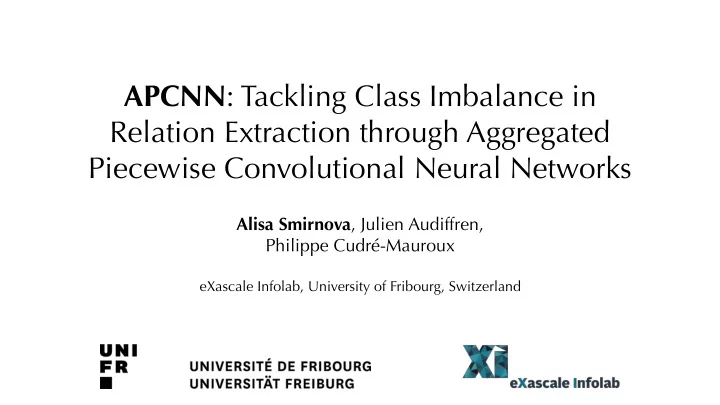

APCNN : Tackling Class Imbalance in Relation Extraction through Aggregated Piecewise Convolutional Neural Networks Alisa Smirnova , Julien Audiffren, Philippe Cudré-Mauroux eXascale Infolab, University of Fribourg, Switzerland
Table of Contents - Problem definition and challenges - Our approach - Experimental results - Conclusion � 2
Relation Extraction Relation extraction is the task of extracting structured information from unstructured text data. Automatically. � 3
Example � 4
Challenges - Text corpora nowadays are extremely large. - Only few annotations are available. Distant supervision technique allows to automatically label any amount of data. � 5
Distant Supervision M. Mintz et al. "Distant supervision for relation extraction without labeled data." ACL, 2009. A. Smirnova and P. Cudré-Mauroux, “Relation extraction using distant supervision: A survey.” ACM Computing Surveys, 2019. � 6
Challenges - Label noise - Label scarcity - Label imbalance � 7
Label Noise Elon Musk is the co-founder, CEO and Product CEO Architect at Tesla . Elon Musk says he is able to work up to 100 hours ? per week running Tesla Motors � 8
Label Scarcity � 9
Label Imbalance � 10
Our Approach (APCNN) - Tackles label scarcity problem - Tackles label imbalance problem - Takes into account wrong labels � 11
APCNN The model consists of two sub-models: - Binary classifier distinguishes “No relation” from “Some relation”. - Multiclass classifier predicts exact relation label. - Both sub-models are convolutional neural networks. Input of each classifier is a bag – a set of all sentences mentioning the same entity pair. � 12
Input Representation word position embedding embedding quick -2 -7 -1 -6 brown 0 -5 fox jumps 1 -4 over 2 -3 the 3 -2 4 -1 lazy dog 5 0 For word embeddings we used Word2Vec [T. Mikolov et al., 2013]. � 13
Model Architecture � 14
Random Oversampling - Binary classifier: proportion of positive and negative instances is 1:1. - Multiclass classifier: proportion of the most frequent relation and the rarest relation is 5:1. This technique helps tackle both label scarcity and label imbalance. � 15
Loss Function Ordered weighted average (OWA) of the probabilities of the sentences in bag is defined as follows: ℬ can be interpreted as a weight that we are giving to the λ sentences in the bag that do not maximize the probability of the relation. � 16
Loss Function Loss Function for Multiclass classifier is defined as follows: 𝒦 ( ℬ ) = − w r log( p loss ( r | ℬ )) – weight of the relation which is inversely proportional to w r the size of the class. Loss Function tackles label imbalance and increases convergence speed. � 17
Predictions - – probability of “None” relation predicted by Binary p None classifier - – probability of relation predicted by Multiclass i = 1.. n p ( i ) classifier � 18
Predictions The final probability distribution is defined as follows: p ( r ) - If : p None = p None p None > τ - If : p None = ϵ p None ≤ τ - Probability of relation : i p ( i ) = p i (1 − p None ) τ and are hyperparameters selected by cross-validation. ϵ � 19
Evaluation Two widely used datasets: ‣ NYTimes (New York Times articles; KG: Freebase) ‣ Wiki-KBP (Wikipedia articles; KG: Wikipedia Infoboxes) Metrics used: ‣ ROC AUC (for binary classification) ‣ Weighted accuracy and confusion matrix (for overall performance) � 20
Baselines - PCNN [1]: Piecewise Convolutional Neural Network; uses the same input representation; loss function takes into account only the sentence maximizing the correct relation label. - CoType [2]: jointly extracts entities and relation using various lexical and syntactic features. [1] D. Zeng et al. (2015). [2] X. Ren et al. (2017). � 21
Weighted Accuracy (NYT) APCNN 25.74% PCNN 13.47% CoType 46.03% � 22
Weighted Accuracy (Wiki) APCNN 77.70% PCNN 60.58% CoType 85.43% � 23
Confusion Matrix APCNN @ NYT PCNN @ NYT CoType @ NYT � 24
Confusion Matrix APCNN @ Wiki-KBP CoType @ Wiki-KBP PCNN @ Wiki-KBP � 25
Conclusion - Big challenges in relation extraction are label noise, label scarcity and label imbalance. - Our model achieves a good balance between predicting the existence of a relation and distinguishing between a set of known relations. - Future work might include the combination of APCNN and CoType. � 26
Thanks for your attention!
Recommend
More recommend